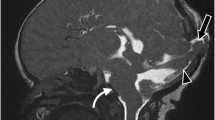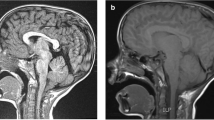Abstract
There are few reported cases of tectocerebellar dysraphia with occipital encephalocele (TCD-OE) in the literature. This malformation was first described by Padget and Lindburg in 1972 and consists of an occipital encephalocele, a cerebellar midline defect, inverted cerebellum, and deformity of the tectum. Occurrence is believed to be sporadic with a male predominance and a usually poor prognosis. We report a patient with brain MRI findings compatible with tectocerebellar dysraphia and occipital encephalocele. Additional features consistent with Joubert syndrome including deepened interpeduncular fossa, as well as elongated, thickened, and anteroposteriorly oriented superior cerebellar peduncles, were noted. The patient’s evaluation also revealed a homozygous mutation of the TMEM231 gene, known to cause Meckel-Gruber and Joubert syndromes. Our case represents the first reported genetic confirmation that tectocerebellar dysraphia with occipital encephalocele is not a distinct nosological entity but likely a phenotypic variation of Joubert syndrome.



Similar content being viewed by others
References
Padget DH, Lindenberg R (1972) Inverse cerebellum morphogenetically related to Dandy-Walker and Arnold-Chiari syndromes. Johns Hopkins Med J 131:228–246
Friede RL, Boltshauser E (1978) Uncommon syndromes of cerebellar aplasia II; tecto-cerebellar dysraphia with occipital encephalocele. Dev Med Child Neurol 20:758–763
Srour M, Hamdan FF, Schwartzentruber JA, Patry L, Ospina LH, Shevell MI, Désilets V, Dobrzeniecka S, Mathonnet G, Lemyre E, Massicotte C, Labuda D, Amrom D, Andermann E, Sébire G, Maranda B, FORGE Canada Consortium, Rouleau GA, Majewski J, Michaud JL (2012) Mutations in TMEM231 cause Joubert syndrome in French Canadians. J Med Genet 49(10):636–641
Maglic D, Stephen J, Malicdan MC, Guo J, Fischer R, Konzman D, NISC Comparative Sequencing Program, Mullikin JC, Gahl WA, Vilboux T, Gunay-Aygun M (2016) TMEM231 gene conversion associated with Joubert and Meckel-Gruber syndromes in the same family. Hum Mutat 37(11):1144–1148
Shaheen R, Ansari S, Mardawi EA, Alshammari MJ, Alkuraya FS (2013) Mutations in TMEM231 cause Meckel-Gruber syndrome. J Med Genet 50(3):160–162
Poretti A, Singhi S, Huisman TA, Meoded A, Jallo G, Ozturk A, Boltshauser E, Tekes A (2011a) Tecto-cerebellar dysraphism with occipital encephalocele: not a distinct disorder, but part of the Joubert syndrome spectrum? Neuropediatrics 42(4):170–174
Komiyama A, Toda H, Johkura K, Kataoka M, Yamamoto I (1999) Pretectal pseudobobbing associated with an expanding posterior fossa cyst in tectocerebellar dysraphia: an electrooculographic study. J Neurol 246:221–223
Dehdashti AR, Abouzeid H, Momjian S, Delavelle J, Rilliet B (2004) Occipital extra- and intracranial lipoencephalocele associated with tectocerebellar dysraphia. Childs Nerv Syst 20:225–228
Demaerel P, Kendall BE, Wilms G, Halpin SFS, Casaer P, Baert AL (1995) Uncommon posterior cranial fossa anomalies: MRI with clinical correlation. Neuroradiology 37:72–76
Timur H, Sanhal CY, Tokmak A et al (2015) Prenatal diagnosis of tectocerebellar dysraphia with occipital encephalocele. J Clin Diagn Res 9(12):QD05–QD07
Agrawal A, Joharapurkar SR, Khan AU (2010) Tecto-cerebellar dysraphia manifesting as occipital meningocoele associated with congenital melanocytic nevi and pectus excavatum. Iran J Pediatr 20(1):118–122
Anik I, Koc K, Anik Y, Yildiz DK, Ceylan S (2010) Tectocerebellar dysraphism with vermian encephalocele. J Child Neurol 25(11):1411–1414
Krishnamurthy S, Kapoor S, Sharma V, Prakash A (2008) Tectocerebellar dysraphia and occipital encephalocele: an unusual association with abdominal situs inversus and congenital heart disease. Indian J Pediatr 75(11):1178–1180
Hartill V, Szymanska K, Sharif SM, Wheway G, Johnson CA (2017) Meckel–Gruber syndrome: an update on diagnosis, clinical management, and research advances. Front Pediatr 5:244
Reiter JF, Leroux MR (2017) Genes and molecular pathways underpinning ciliopathies. Nat Rev Mol Cell Biol 18(9):533–547
Parisi MA, Doherty D, Chance PF et al (2007) Joubert syndrome (and related disorders) (OMIM 213300). Eur J Hum Genet 15(5):511–521
Poretti A, Huisman TA, Scheer I et al (2011b) Joubert syndrome and related disorders: spectrum of neuroimaging findings in 75 patients. Am J Neuroradiol 32(8):1459–1463
Chowdhary UM, Ibrahim AW, Ammar AS, Dawodu AH (1989) Tecto-cerebellar dysraphia with occipital encephalocele. Surg Neurol 31(4):310–314
Salonen R (1984) The Meckel syndrome – clinicopathological findings in 67 patients. Am J Med Genet 18:671–689
Author information
Authors and Affiliations
Corresponding author
Ethics declarations
Conflict of interest
The authors declare that that they have no conflict of interest.
Additional information
Publisher’s note
Springer Nature remains neutral with regard to jurisdictional claims in published maps and institutional affiliations.
Rights and permissions
About this article
Cite this article
Nicolas-Jilwan, M., Al-Ahmari, A.N., Alowain, M.A. et al. Tectocerebellar dysraphia with occipital encephalocele: a phenotypic variant of the TMEM231 gene mutation induced Joubert syndrome.. Childs Nerv Syst 35, 1257–1261 (2019). https://doi.org/10.1007/s00381-019-04048-9
Received:
Accepted:
Published:
Issue Date:
DOI: https://doi.org/10.1007/s00381-019-04048-9




